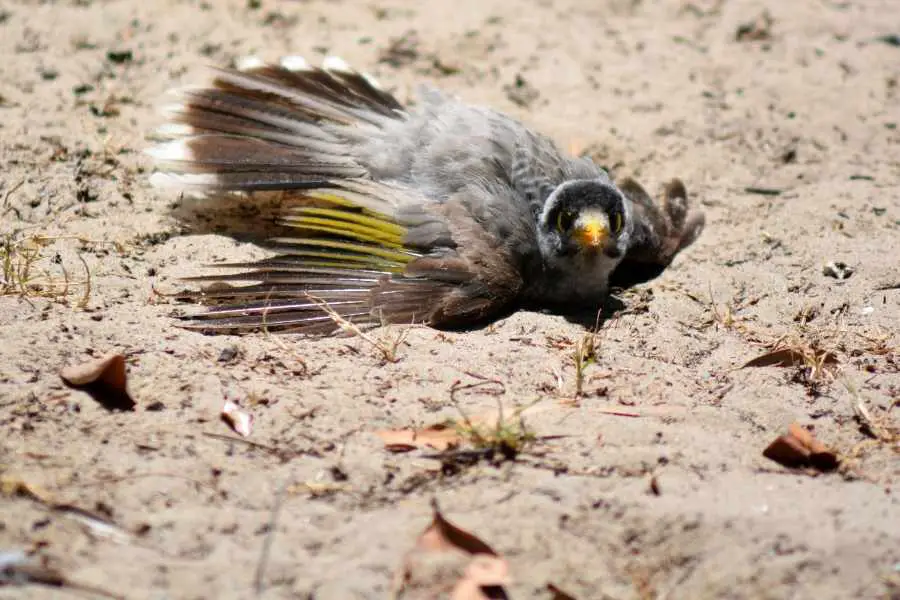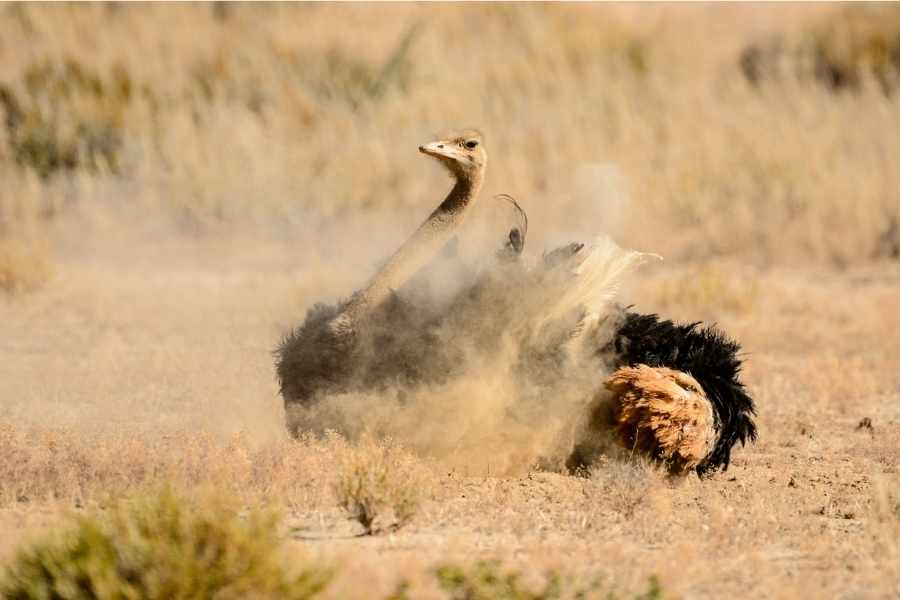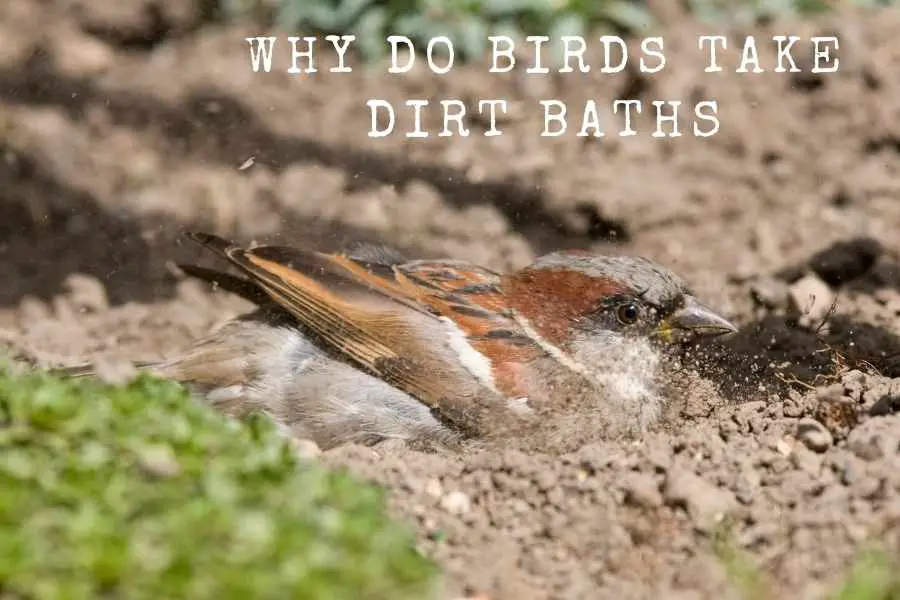Dust baths are also referred to as dirt baths, sand baths, or dusting and are essential for the health of some birds. So, why do birds take dirt baths? This article examines the why, how, and how often birds take dust baths. Additionally, we’ll look at which birds take dust baths and how birds take dust baths.
Usually, we see birds taking baths in water, but equally, it is not uncommon to see a bird taking a bath in dusty, dry sand. Some birds love taking dust baths just like other birds love water baths.
Over a hundred different types of birds love taking dust baths. Birds like the sparrow or the wren take a dirt bath even after taking a water bath, underscoring the importance of dusting in birds.
But why do birds take baths in the dirt? Dirt baths help a bird maintain its feathers and plumage in good shape and condition. A bird’s feathers play vital roles, such as insulation and helping the bird maintain its waterproofing and aerodynamic flight capacities.
During sand bathing, the dry sand absorbs excess oil and lipids from the bird’s feathers; this way, the feathers do not become greasy. Another reason birds take dirt baths is because it helps get rid of ectoparasites and pests on the bird’s skin, such as lice and feather mites.
It is not just birds that love dirt baths; mammals do too! Elephants, rabbits, and donkeys love dusting to maintain their skins in better condition. Elephants like wallowing in the mud to cool off their bodies. Sand bathing can be compared to wallowing in the mud in that both are body maintenance activities.
What Happens When A Bird Takes A Dust Bath?

When dusting, you see the bird wriggling its body while flapping its wings in the sand/dirt. The bird makes spirited and erratic movements while kicking up a cloud of dust. Surprisingly, the bird always seems to be enjoying itself, chirping in happiness even when it assumes crazy body positions while sand bathing.
The bird’s oil gland releases oil absorbed by the dust; the bird’s feathers absorb just enough of the oil as the bird frenziedly wades and moves in the oily sand.
Also Read About How Often Your Pet Bird Should Read
The bird’s objective is to get as many sand particles onto the bird’s skin as possible. When the oil-soaked sand is shed from the bird’s feathers, it is expelled with dead skin, debris, excess feather lipids, and parasites. Another reason why birds bathe in dirt is to allow the dry sand to smoother and suffocate external parasites like lice and mites.
Parasites and mice can cause serious health issues in a bird, such as itchy skin, anemia, loss of feathers, and can kill the bird. External parasites can cause avian malaria. Sand bathing is a healthy activity that minimizes the risk of disease and infection in birds.
What Birds Take Dust Baths
Examples of birds that take regular dirt baths include sparrows, bluebirds, kestrels, larks, thrushes, raptors, robins, and wrens. Also, many species of songbirds like to take dust baths to maintain their feathers in the proper condition. Wrens and sparrows take a dirt bath after a water bath to get rid of external parasites.
The house sparrow is an ordinary city bird that loves dust baths. The home sparrow will take a sand bath even when water is available. Unsurprisingly, its origin can be traced back to arid areas in Israel, where birds are likely to take sand baths and save the scarce water for drinking.
Do quail need dust baths? For example, the California quail is a social bird that loves dusting in a group. While some birds love to dust alone, others prefer to take dust baths in their flocks. Additionally, the California quail enjoys bathing in freshly turned soil.
Other birds that take regular sand baths include seagulls, herons, guinea fowl, pheasants, ducks, chickens, wild turkeys, grouse, and partridges.
Birds that do not have the uropygial gland use dirt baths to maintain dry and healthy feathers. They include bustards, ostriches, emus, and kiwis. These birds use sand baths to maintain healthy and dry feathers.
Under the right conditions, chickens also love taking dirt baths—chickens like taking dirt baths in soft, dry, and dusty topsoil. Domestic chickens have been used to study sand bathing in chickens.

How A Bird Dust Baths
The bird begins by grinding its feet in dry, dusty sand or dirt to make a hollow. Some birds, like hens, use their beaks to rake the ground when forming the shallow depression.
The bird then uses its body to burrow itself in the dirt, lowering its underbelly and neck into the dirt while throwing dirt over its feathers and below its wings. It usually shakes its wing vertically, rubs its head in the dirt, or scrapes the soil with the tip of its lower beak or one leg to gather dirt on its body and skin.
The dust needs to have fine particles and be free of clumps, rocks, vegetation, and animal droppings to serve its purpose.
Like bathing in water, the bird flaps its wings furiously, creating a storm of dust while trying to take in as much dust in its feathers and on its body as possible. When dusting, the bird likes to spread its neck and tail and fluff up its feathers to ensure its entire body (skin and feathers) gets dirt.
The bird will kick, upset and fan the dust using its feathers. You can also see the bird ruffling its feathers and flapping its wings when dusting.
Between taking breaks to rest and making glances here and there, the bird repeats these motions until it is well covered in sand. Then, the bird will shake off excess dirt and fly off to perch to bask in the sun and preen itself.
Preening helps align the bird’s feathers properly to neighboring feathers and helps the bird attain its shape. Preening also helps the birds spread preen oil all over their feathers, keeping the feathers flexible, healthy, waterproof, and ready for flight. Accordingly, many birds will preen themselves several times during the day.
After a dust bath and a good preen, the bird’s wings become fluffier and better conditioned for flight.
How Often Does A Bird Take Dirt Baths?
The frequency of taking dust baths varies depending on the bird species, the season of the year and local climatic conditions. For instance, birds found in arid areas love dust baths and like preserving the scarce water for drinking.
The time of the day also influences how often a bird takes dust baths, with most sand baths occurring during the mid-hours of the day. Suitable sand also determines how often your bird takes a dust bath.

Birds That Dig Holes In The Ground
Usually, birds dig holes in the dirt when scavenging for food, such as worms, grubs, and insects. However, after digging holes for other reasons, they can use the excavated dirt for their dust baths.
For instance, sparrows like to dig holes in the dirt for various reasons: to look for food, shelter, or a safe place to keep their eggs warm. They like digging holes in areas shielded from strong winds and away from their predators.
Sparrows use this dirt for dusting, which cleans their skins and feathers and maintains them in top condition.
How To Make A Bird Dust Bath In Your Backyard
You must have a dust bath nearby so your bird can take a bath anytime it feels like it. A bird will take a dust bath whenever it is time to groom its feathers, provided it is appropriate, dry dust or dirt nearby.
When making a dirt bath, the first step is site location; identify where you want to place the dirt bath. The areas that experience full sunshine are the ideal places to make your bird’s dust bath. Alternatively, you can locate the dirt bath in an area where your bird likes to take a dirt bath.
Simultaneously, you need to cover the dust bath to stop the rain from wetting the area and the neighborhood cats peeing or pooping in your bird’s dust bath. Look for a suitable cover to keep the dust bath dry.
It is also essential to find ways of making the dust bath a safe and inviting environment for your bird.
What You Need To Make A Bird Dust Bath
Materials
- Fine sharp/grit/river sand: The dirt/sand needs to be fine-grained without rocks, plant materials, and animal droppings.
- Four (4) timber pieces of 4″ x 2″, each measuring 40″ inches.
- One (1) piece of expanded wire mesh measuring 40″ x 40″
- One (1) piece of landscaping weed control material measuring 40″ x 40″
- Four (4) bricks.
- One (1) packet of 4″- inch timber deck screws
- One (1) bag of 1″-inch nails
Construction Procedure
Step 1: Clear and level the area where the dust bath will be set up.
Step 2: The goal is to make a square structure using the four timber pieces. Place the two pieces at a 90-degree angle to one another. Drill two holes (for the screws) and fasten the two timber pieces together using the 4″ inch screws.
Step 3: Repeat step 2 for the remaining two pieces of wood.
Step 4: Join the two assembled parts to form a square structure.
Step 5: Put the wire mesh on the square structure and secure the mesh using 1″ screws.
Step 6: Turn around the structure such that the bottom part is facing upwards.
Step 7: Place the landscaping weed control material in the square box and use the 1″ inch to secure it to the frame.
Step 8: Place the four bricks on the box’s four corners.
Step 9: It’s time to put the sand in the box. However, ensure you sieve the sand using a builder’s sieve before putting the sand in the box. As earlier mentioned, you need fine-grained sand for this role.
At this point, the construction of the sand bath is complete.
Alternatively, instead of constructing the dirt bath structure, you can opt to buy a durable plastic container of similar dimensions.
If you buy a container, drill about 20 holes on the lower side of the container before you fill it with loose, dry, and dusty sand. Ensure the sand remains dry by placing the container in an elevated position above the ground.
Birds In Your Backyard Are A Sign Of Good Environmental Health
Building a sand bath will prevent birds from messing up your lawn or backyard if you live in a bird-friendly area. They will opt to use the well-constructed space for sand bathing. You will probably enjoy seeing birds taking dirt baths; many people find it cute and fun.
You can invite birds into your backyard by providing water, food, and a sand bath! According to Audubon California, if you have a healthy populace of native birds, it means that the surrounding ecology is healthy.
How To Encourage Your Bird To Take Dust Baths
Consider erecting a few dead tree branches for your bird/s to perch on when not dusting. After a good sand bathing session, the bird will likely preen itself on these perches.
Another way to encourage your bird to take sand baths is to add herbs to the newly-constructed sand bath. Herbs like thyme, rosemary, lavender, and will invite your bird to the sand.
Birds also love sunflower and suet. Also, consider providing foods like safflower, mealworms, peanut butter, nuts and thistle.
Also, ensure you maintain the dust bath in top condition to attract your bird to enjoy a dust bath whenever it wants.
Consider putting up a suitable bird haven nearby where your bird can run into whenever it feels frightened when taking a sand bath.
The Best Colors To Paint A Bird’s Sand Bath Structure
Different colors will appeal to different species of birds. For instance, blue attracts blue jays, yellow is best for goldfinches, and green attracts skittish birds. Do not use the white color, which frightens off birds.
Orange, pink, red, or other bright colors will attract your bird to the sand bath.
Is Your Pet Bird Shivering After Taking A Birth, Read This Article!
Conclusion: Why Do Birds Take Dirt Baths?
So, why do birds bathe in dirt? Dust baths help a bird to remain happy and healthy. By constructing a dust bath for your bird, you can help it fight mild infections and lice.

